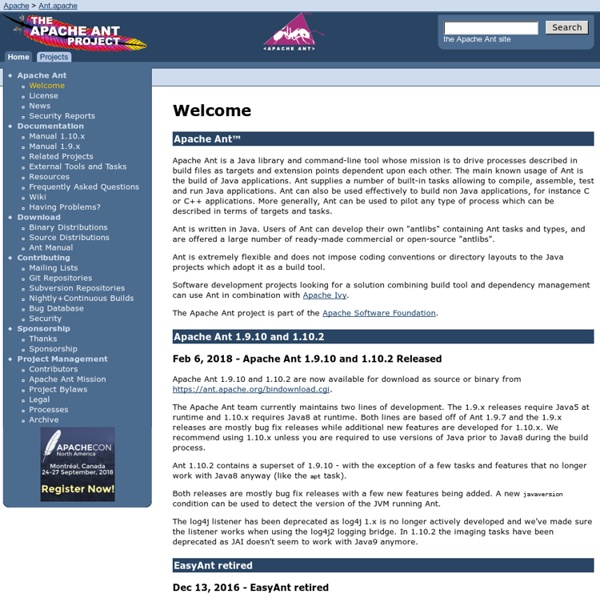Ant Tutorial: Hello World
This document provides a step by step tutorial for starting java programming with Apache Ant. It does not contain deeper knowledge about Java or Ant. This tutorial has the goal to let you see, how to do the easiest steps in Ant.
Time - Java date and time API - Home
Release 2.7 is the current latest release. This release is considered stable and worthy of the 2.x tag. See the upgrade notes for full details.
Apache Camel
Apache Camel is a rule-based routing and mediation engine that provides a Java object-based implementation of the Enterprise Integration Patterns using an API (or declarative Java Domain Specific Language) to configure routing and mediation rules. The domain-specific language means that Apache Camel can support type-safe smart completion of routing rules in an integrated development environment using regular Java code without large amounts of XML configuration files, though XML configuration inside Spring is also supported. Camel is often used with Apache ServiceMix, Apache ActiveMQ and Apache CXF in service-oriented architecture infrastructure projects.
What's New in Java 8 by Adam L. Davis
Java 8 is a giant step forward for the Java language. In Project Lambda, Java gets a new closure syntax (lambda expressions), method-references, and default and static methods on interfaces. It manages to add many of the features of functional languages without losing the clarity and simplicity Java developers have come to expect. In addition, many of the existing Java core library classes have been enhanced with the new Streams API. This ebook will help you understand Java 8, including: Project Lambda, the new Date-Time API, Streams, default methods, Nashorn, and more.
Apache ActiveMQ
Coinciding with the release of Apache ActiveMQ 5.3, the world's first results for the SPECjms2007 industry standard benchmark were announced. Four results were submitted to the SPEC and accepted for publication. The results cover different topologies to analyze the scalability of Apache ActiveMQ in two dimensions.[4][5] See also[edit] References[edit] Bibliography[edit]
Tail Call Optimization and Java
I was recently asked whether Java SE 8 contained an optimization for tail calls, which are a special kind of function call. This optimization is most relevant for recursive calls, which are particularly important for functional languages, as they often rely on recursive design and coding patterns. In this article, I examine exactly what a tail call is, how it can be optimized effectively, and where Java 8 stands in terms of implementing this optimization. Before we dive in, let's define a tail call. What is A Tail Call? A tail call is a fancy term that refers to a situation in which a method or function call is the last instruction inside of another method or function (for simplicity, I'll refer to all calls as function calls from now on).
JBoss ESB
JBossESB is the next generation of EAI - better and without the vendor-lockin characteristics of old. As such, many of the capabilities mirror those of existing EAI offerings: Business Process Monitoring, Integrated Development Environment, Human Workflow User Interface, Business Process Management, Connectors, Transaction Manager, Security, Application Container, Messaging Service, Metadata Repository, Naming and Directory Service, Distributed Computing Architecture. Plus JBossESB is part of an SOI (Service Oriented Infrastructure). However, SOA is not simply a technology or a product: it's a style of design, with many aspects (such as architectural, methodological and organisational) unrelated to the actual technology.
Open ESB Wiki
OpenESB is a Java-based open source enterprise service bus. It can be used as a platform for both Enterprise Application Integration and Service Oriented Application. OpenESB allows you to integrate legacy systems, external and internal partners and new development in your Business Process.




I know there are macros that are supposed to allow re-usable tasks but I have still found this to be limiting. by superunknown Apr 10
If you are going to use, would recommend using to pull down dependencies and publish artifacts to something like sonatype next or artifactory. by superunknown Apr 10